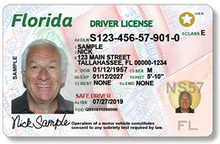Driver's license (United States)
Driving licenses in the United States (English. Driver's licenses ) are by the individual states issued. The driving license classes are largely uniformly regulated, professionally necessary driving license classes ( commercial licenses ) are uniformly divided according to a Code of Federal Regulations (49 CFR 383).
Driver training
The required driver training in the majority of states includes theoretical and practical instruction. The exam includes:
- written theory test
- practical driving test
- Test of knowledge of the traffic signs (including sufficient knowledge of the English language to understand the traffic signs)
- Eye test
- Proof of legal residence in the USA
Minimum age
In the USA , the minimum age for obtaining a driver's license is regulated by individual states . A fully valid driver's license (full license) can be in 22 countries with 18 years, in ten states the age of 17 and in 15 countries with 16 to 16½ years acquired. In the District of Columbia , full driver's licenses are only issued to individuals aged 21 and over. A driving license on probation (restricted license or provisional license) can be obtained in 37 states at 16 to 16½ years, in 5 states with 15 to 15½ years and in two other states ( North Dakota , South Dakota ) already at 14½ years. A learner's permit, which allows novice drivers to drive a vehicle independently when accompanied by an unrestricted passenger, can be obtained in nine states from 16 years of age, in 28 states from 15 to 15½ years and in eleven states from 14 to 14½ years become.
ID function
Since there is no in the United States identity card is in the true sense, serves as a substitute frequently the driving license with photo, which is issued on request for non-drivers as State Identity Card ( ID card ). With the Real ID Act of 2005, the security features were standardized nationwide. Driving licenses and state identity cards are recognized by all federal authorities as proof of identification using this format, e. B. for domestic flights. All but three states have implemented the Real ID Act . (Status: 2019)
The driver's license and State ID are mutually recognized by all states as valid identity documents. The basis for this is that laws of the individual US states are to be recognized in every other state ( Article 4 of the US Constitution : Full Faith and Credit Clause ). This in connection with the almost nationwide implementation of the REAL ID Act have de facto developed the driver's license and the State ID into a nationwide valid ID document.
References and comments
- ↑ Part 383: Commercial driver's license standards; requirements and penalties - Federal Motor Carrier Safety Administration . DOT.gov. Retrieved December 29, 2012.
- ↑ For an overview see: Driver's license in the United States #Licensing Laws by State in the English language Wikipedia.
- ^ Department of Homeland Security: REAL ID, accessed August 27, 2018.

